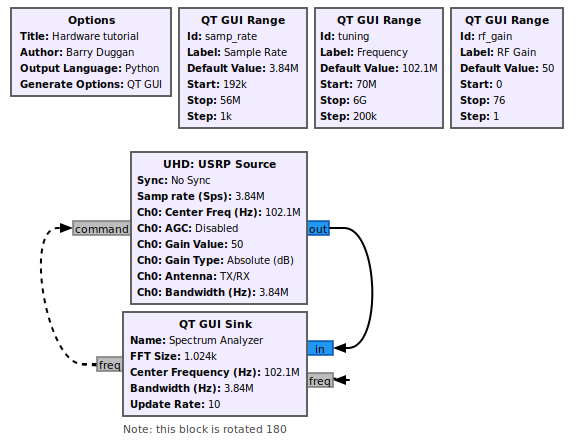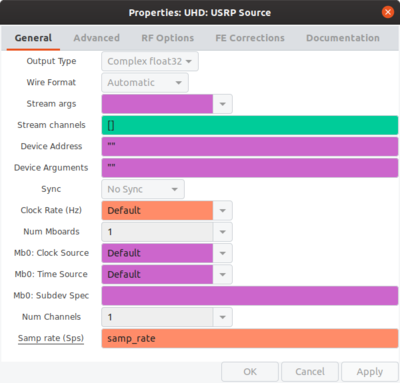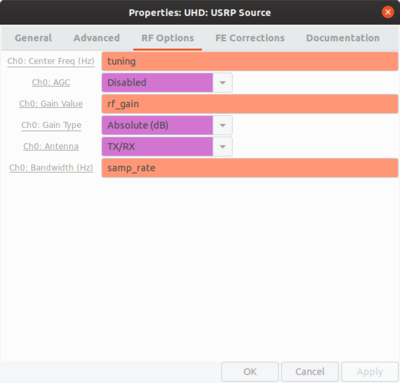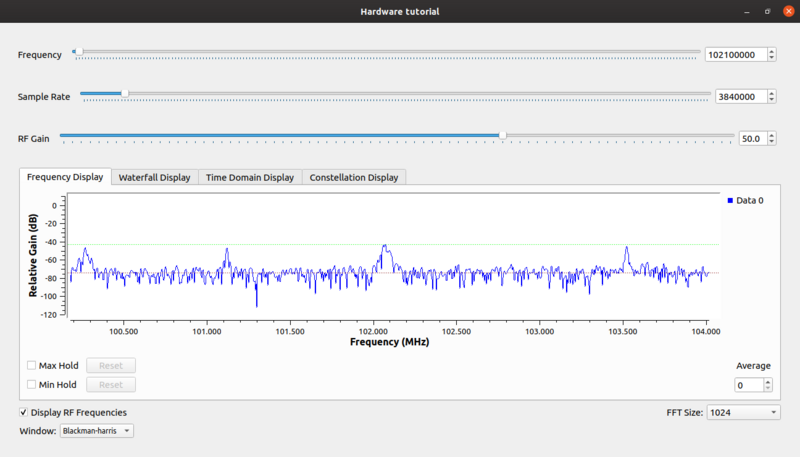User:Duggabe
DRAFT 3rd REVISION Guided_Tutorial_Hardware_Considerations
Introduction
One of the more basic (and also incredibly useful) things you can do in GNU Radio with a receiver is to create a software radio spectrum analyzer. This is also a great first step because it will verify that your hardware has basic functionality.
Prerequisites
- Tutorials:
What Will I Need?
There is a large and growing number of SDRs that have GNU Radio support. They span from very cheap ($20) receivers like the RTL-SDR to very high-performance tens-of-thousands-of-dollars systems. Parameters for four popular devices are presented below. Other devices are listed in Hardware.
Creating a Software Radio Spectrum Analyzer
This example uses an USRP Source block, so it should work for almost all USRP SDRs, such as the USRP B series which have a continuous frequency coverage from 70 MHz to 6 GHz and a maximum sample rate of 56 MHz.
In order to use UHD blocks, you must have UHD installed. See Installing the USRP.
Using gnuradio-companion (GRC) and the following Block descriptions, build this flowgraph.
Setting Parameters
The parameters are set as shown:
Tuning and Using the Spectrum Analyzer
Set the following parameters in the QT GUI Sink block:
- Center Frequency (Hz): tuning
- Bandwidth (Hz): samp_rate
- Show RF Freq: Yes
The analyzer can be tuned with the Frequency control widget. If you check the "Display RF Frequencies" box in the run-time GUI window, then the scale on the 'Frequency Display' and 'Waterfall Display' tabs will show the actual frequencies with the tuned frequency in the center.
With the message output of the QT GUI Sink block (freq) connected to the message input (command) of the USRP Source, you can double click the display on the Frequency or Waterfall screens and it also will tune to the selected frequency. Before you click, the frequency will be displayed with the cursor.
You can adjust the Sample Rate to see the effects on the received spectrum. This trace shows four FM stations.
Hardware Considerations
Setting the sample rate involves several factors to consider.
- The various hardware devices have limits on what sample rates they can deliver. Some, such as the FunCube Pro+, have a fixed sample rate of 192kHz. Setting the flowgraph sample rate must be within the limitations of the device.
- The computer hardware and operating system you are using will set limitations on the data throughput, such as:
- USB2 vs USB3
- processor speed
- number of CPU cores
- Data overruns are indicated by the letter 'O' displayed on the terminal screen. These are because the input data stream is producing data faster than the flowgraph can consume it. Adjusting the sample rate and/or the input buffer size (where available) should alleviate the problem.
Building an FM Receiver
Now that you have a tested input device, you can build an FM Receiver with it. See the following examples and use your hardware.
For audio considerations, see Audio_Sink.



